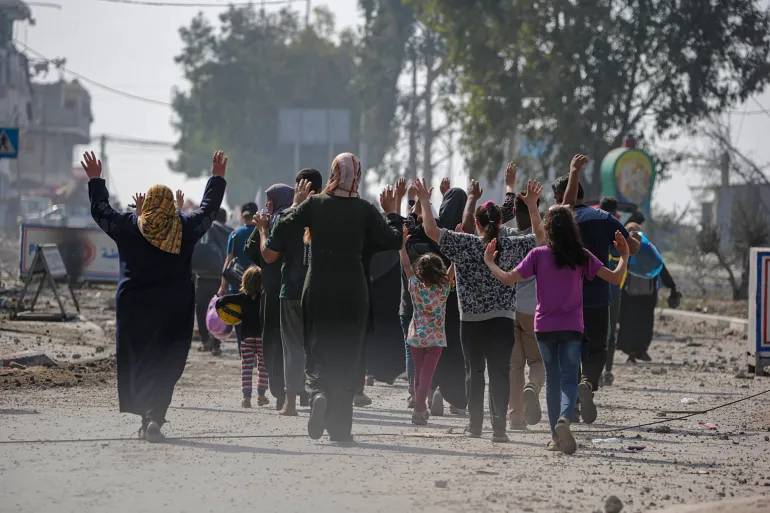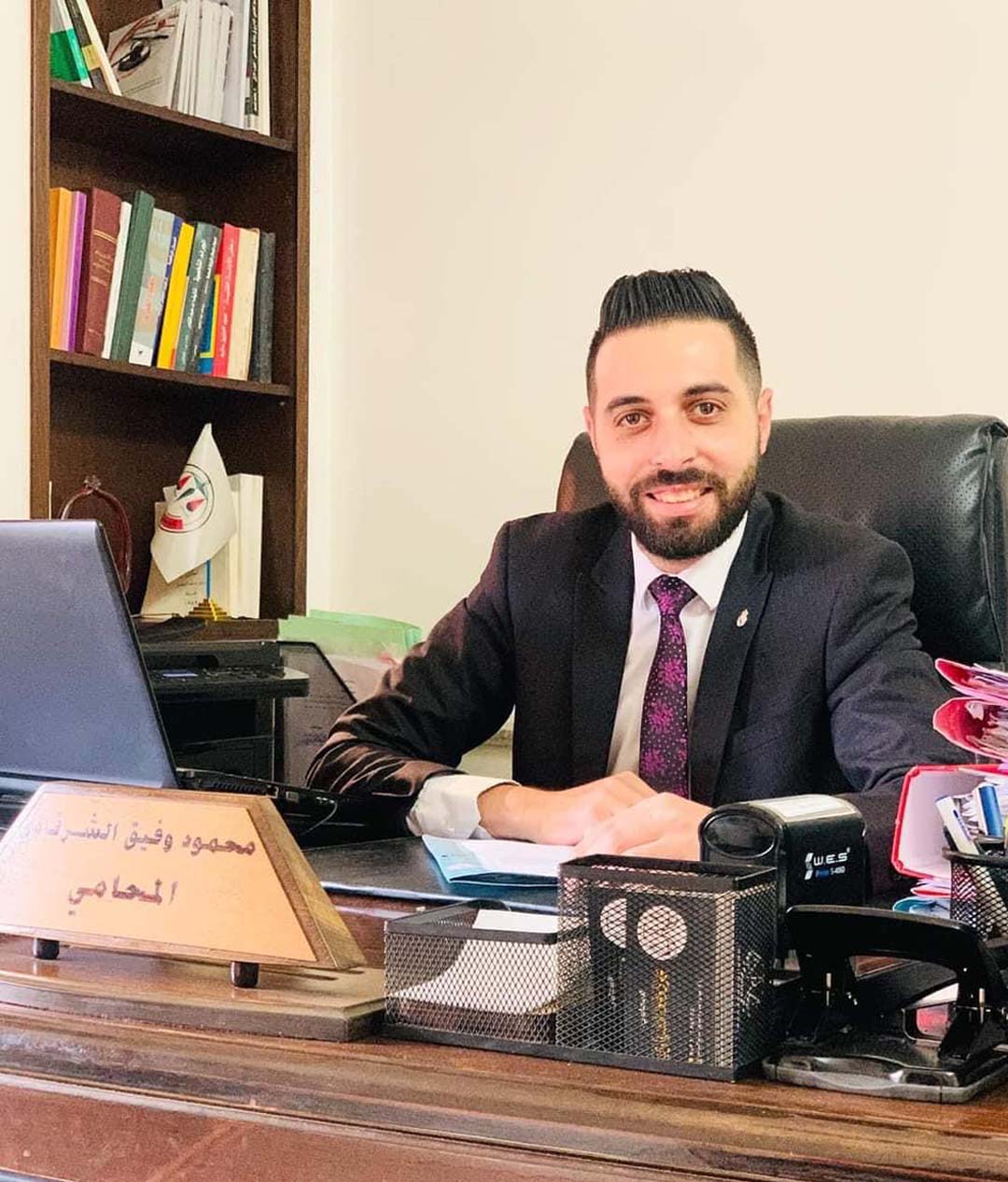
Monthly Report on Internal Displacement Monitoring in the Gaza Strip - November 2024 Published on January 5, 2025
This report monitors and analyzes internal displacement in the Gaza Strip during November 2024. It is based on an examination of the measures implemented by the Israeli military during its large-scale opx`eration initiated in October 2023. The analysis includes data and maps issued by the Israeli military, reports from the field, and observations regarding displacement movements within Gaza. It also drx`aws on information provided by official authorities, international organizations, and local NGOs operating in the Gaza Strip.
The Gaza Strip is a narrow coastal territory spanning 365 square kilometers, situated between Israel, Egypt, and the Mediterranean Sea. Home to approximately 2.2 million people, it is one of the most densely populated areas in the world. On September 11, 2005, the Israeli army unilaterally withdrew from Gaza. Since then, the region, governed by Hamas, has been subjected to periodic large-scale military operations, resulting in tens of thousands of civilian casualties and widespread destruction of infrastructure.
On October 7, 2023, Hamas launched a significant military operation targeting Israeli forces in the Gaza periphery. In response, the Israeli military announced the launch of a large-scale offensive named "Iron Swords." This offensive, the most severe in Gaza's history, forced nearly 2 million Palestinians to flee their homes. Hundreds of thousands have since been prohibited from returning to their original areas of residence, with movement between northern and southern Gaza heavily restricted.
October 31, 2024 – 8:00 p.m.
Israeli occupation forces stationed in the northern Wadi Gaza area launched a military offensive with tanks, warplanes, and drones targeting the northern and western parts of the Nuseirat Refugee Camp—specifically the New Camp and Camp No. 5—as well as the Da’wa and Ard al-Mufti areas. Occupation vehicles advanced into northern and northwestern areas of Nuseirat, causing massive destruction and resulting in numerous deaths and injuries. Gunfire and shell fragments reached as far as the As-Sawarha area southwest of Nuseirat. The Israeli army did not formally announce any military operation in those areas nor warn residents to evacuate. Local estimates indicate that approximately 5,000 people were displaced from the targeted and surrounding areas to southern Nuseirat, Al-Zawaida, Deir al-Balah, and Khan Younis. On November 2, 2024, without any official announcement, Israeli forces withdrew from the previously mentioned northern and northwestern parts of Nuseirat, having inflicted extensive damage on civilian buildings and public facilities. This operation left around 63 people dead and dozens wounded. According to testimonies from local residents, a partial return of displaced persons to their areas of origin was subsequently recorded.
November 3–4, 2024
- Around 10:00 p.m. on November 3, 2024: Intense artillery and aerial bombardment prompted a wave of displacement from the southern neighborhoods of Khan Younis, particularly from Al-Manara, parts of Qizan an-Najjar, and Sheikh Nasser. Although the Israeli army did not announce any operation in that area, heavy airstrikes continued until dawn on November 4, resulting in nine fatalities, including four children, and dozens of injuries. The shelling subsided in the early morning hours.
- Ongoing Operation in Jabalia (October 8–November 4, 2024)
On October 8, 2024, Israeli occupation forces launched a wide-scale military operation in Jabalia (referred to as Area “D” in the latest map published by Israeli military media). This area encompasses most of northern Gaza, including Jabalia, Beit Lahia, Beit Hanoun, and surrounding camps. From that date until November 4, more than 71,000 people were displaced from the North Gaza Governorate to Gaza City. Palestinian medical sources reported that by November 4, at least 1,800 people had been killed and over 4,000 injured. They further described the humanitarian situation in northern Gaza as “unprecedentedly catastrophic,” with Israeli forces targeting civilians who refused to leave and intensifying the blockade. UNICEF announced that, between November 6 and 8, 2024, more than 50 children had been killed in Jabalia alone after airstrikes destroyed two buildings housing hundreds of people. - November 4, 2024
A team from the Palestinian Observatory for Internal Displacement recorded the establishment of the first camp of displaced persons in Gaza City, consisting of fabric and plastic tents set up inside Al-Yarmouk Stadium—one of two main stadiums in Gaza that typically host Palestinian football league matches. Photographs showed dozens of tents erected on the grass field, with hundreds of displaced people sheltering inside them. Local sources indicated that many of these displaced were originally from Jabalia and Beit Lahia, who had nowhere else to go.
November 5, 2024 – 7:00 p.m.
Israeli warplanes targeted a tent sheltering displaced individuals in the Az-Zawaida area. The strike killed four displaced persons—including two children and a woman. All four were members of one family (father, mother, son, daughter).
November 6, 2024
- Around 2:00 a.m.: Israeli warplanes targeted a tent sheltering displaced persons in Deir al-Balah, central Gaza Strip, killing two people and injuring six.
- Around 9:00 a.m.: Two elderly individuals were declared dead upon arrival at Al-Ahli Baptist Hospital in Gaza. They had died during forced displacement at the Civil Administration checkpoint east of Jabalia, after being subjected to harsh treatment and left for hours under the sun without water. According to local sources, Israeli forces continue issuing field orders for immediate evacuation to residents in Jabalia and Beit Lahia. Since the start of the operation in northern Gaza, many civilians have been forcibly displaced.
- That day, an Israeli drone reportedly told residents of Ash-Shima’ area, west of Beit Lahia, to evacuate. When residents moved toward the Beit Lahia Project area and local schools, the drone dropped bombs on them, forcing them to retreat under fire.
November 7, 2024 – 8:00 a.m.
The Israeli army warned civilians and displaced persons in the northern Beach neighborhood, An-Nasr, Ibad Al-Rahman, Al-Awda, and Al-Karama to evacuate. Notably, the army had previously directed those fleeing from northern Gaza to these very same areas
November 8, 2024
Israeli Air Force jets bombed a school sheltering displaced persons in An-Nasr neighborhood, west of Gaza City, killing six people and wounding several others.
November 9, 2024 – 9:00 p.m.
Israeli warplanes attacked a tent housing displaced persons in Al-Jazeera Stadium, south of Ash-Shafaei Mosque in Khan Younis. Nine people were killed, and several others were injured, one critically.
Also on November 9, five people (including two children) were killed while sleeping when Israeli forces shelled Fahd Al-Sabah School, which was sheltering displaced persons in the At-Tuffah neighborhood, east of Gaza City.
On the same day, two journalists were killed and three others suffered severe injuries after an Israeli Air Force helicopter targeted a tent inside Al-Aqsa Martyrs Hospital that was housing displaced persons.
November 10, 2024
Civil Defense teams in Khan Younis successfully rescued a displaced individual who had been trapped in a deep hole he was digging near Al-Shuhada Mosque for sewage and wastewater disposal. All displacement camps lack basic infrastructure—particularly sewage systems—and displaced persons rely on dug wells for wastewater drainage. These wells must be expanded or re-dug roughly once a month, posing severe risks to those living in tents and creating numerous health and environmental hazards.
November 11, 2024
The Israeli army announced an expansion of the so-called “humanitarian zone” to include extensive parts of Al-Zawaida and Bani Suheila, even though it continues to carry out intense strikes on many areas it designates as humanitarian.
On the same day, two individuals were killed and several others injured when the occupation bombed a tent sheltering displaced persons in Nuseirat Camp in central Gaza.
Also on November 11, Israeli warplanes targeted an internet hotspot serving displaced persons in Mawasi Khan Younis, killing 11 people and injuring others. This attack came despite the army’s announcement that it was expanding the “humanitarian zone” to eastern Khan Younis and Deir al-Balah. The site attacked is located in the far western part of Khan Younis on Gaza’s coast—well within the newly declared humanitarian zone.
November 12, 2024
Israeli occupation forces operating in northern Gaza broadened their offensive to include Beit Hanoun, besieging its shelter centers and using loudspeakers to call on the displaced to leave.
Later that day, the army targeted a group of displaced persons outside the Mahdiyyah Ash-Shawwa shelter in Beit Hanoun, killing three people and wounding others.
That same day, the occupation forces detained all those who had fled from Beit Hanoun at checkpoint east of Jabalia, after having already forced them to leave their homes. A large number of houses in Beit Hanoun remain besieged, with residents repeatedly ordered to evacuate.
At roughly 10:00 a.m., Israeli forces shelled a residential building near Cairo Hall on the northern Gaza City coast, where people were waiting for aid. This attack resulted in a large number of injuries.
Later on November 12, one person was killed and others injured when Israeli forces struck a tent for displaced persons in Deir al-Balah, central Gaza Strip.
November 15, 2024
- A child, a woman, and another individual were killed when Israeli warplanes struck a tent sheltering IDPs in central Deir al-Balah.
- Israeli forces shelled another tent hosting IDPs in Mawasi Rafah, southern Gaza Strip, killing four people and injuring several others.
- Around 9:00 p.m., Israeli warplanes targeted another tent in the coastal Mawasi area, west of Khan Younis, killing five individuals and wounding one more.
- Around 10:00 p.m., one fatality was reported at Al-Aqsa Martyrs Hospital in Deir al-Balah following a strike on a tent sheltering IDPs west of the city.
November 13, 2024
- Around 11:00 a.m.: Israeli attack helicopters shelled a cooking gas distribution point east of the Samoud Displacement Camp in Mawasi Khan Younis, injuring at least 10 individuals. This location is in the western part of Khan Younis, an area classified by the occupation as “humanitarian.”
- On the same day, two people were killed and about six others injured when the occupation bombed land adjacent to the tents of displaced persons in Mawasi Khan Younis.
- Also on November 13, another strike hit an area next to IDP tents in Mawasi Khan Younis, killing two children and injuring 10. This area, too, was within the so-called “humanitarian zone.”
- In yet another incident, an Israeli airstrike hit a tent sheltering IDPs near the Samoud Camp west of Khan Younis, injuring nine individuals.
- Around 4:00 a.m., Al-Awda Hospital in Nuseirat received five casualties following a strike on a tent for displaced persons near Rathi Gas Station west of Nuseirat, central Gaza.
- That same day, 12 people were injured in another strike on a tent housing displaced persons in the Mawasi area west of Khan Younis.
November 14, 2024 – 3:00 p.m.
Occupation forces targeted the Salah ad-Din School shelter in the Rimal neighborhood of Gaza City, killing four individuals and wounding others. A fire broke out, destroying what remained of the school building, which had already been attacked several times before and was being used to house displaced persons.
November 16, 2024
Khan Younis Municipality announced it had run out of the fuel needed to operate water and sewage pumps, as well as waste collection and disposal vehicles. This fuel shortage denies more than 1.2 million citizens and displaced people access to clean, potable water and also halts trash collection in neighborhoods and displacement camps, which may trigger the spread of harmful diseases.
On the same day, 10 people were killed and around 20 injured by an Israeli attack on the Abu ‘Asi School shelter in the Beach Refugee Camp, west of Gaza City.
November 17, 2024
The monitoring team from the Palestinian Observatory documented how Palestine Stadium in the Rimal neighborhood, west of Gaza City, had been transformed into a displacement camp for residents seeking shelter from the ongoing war.
- Around 8:00 a.m.: A new wave of displacement was observed from the Beit Lahia Project area after drones dropped leaflets over the region.
- That day, five individuals were killed when Israeli forces attacked a group securing humanitarian aid in southern Khan Younis. Local authorities and tribal leaders attempt to protect relief convoys from looting by local gangs, but their efforts often fail, as these gangs receive cover from the occupying forces.
- November 18, 2024
Israeli helicopters targeted a tent sheltering IDPs in the Al-‘Attar area of Mawasi Khan Younis, killing four people (including two children) and injuring a young girl. The casualties were a father, mother, and their children. - Also on November 18, the emergency committee of the Deir al-Balah municipality warned IDPs to evacuate areas near Wadi AL-Salqa, al-Birka, and the beach, due to the high risk of floods as winter arrives. All regions of southern Gaza are already packed with residents and IDPs—even in locations not classified as “humanitarian” by Israel.
November 19, 2024
Rain began to fall across the Gaza Strip in the early hours, flooding the tents of displaced persons at Al-Yarmouk Stadium in central Gaza City. A Civil Defense statement noted that heavy rain had inundated the IDP tents, exacerbating the suffering of hundreds of thousands of displaced families.
- Around 11:00 a.m.: One individual was killed, and others were injured when a drone dropped an explosive near the Beit Lahia School shelter in northern Gaza.
- Also on November 19, another civilian was killed while fleeing near Abu Shurkh Roundabout in Jabalia Camp. Israeli forces targeted a group of people trying to evacuate from northern Gaza to Gaza City.
- On the same day, rainstorms flooded displacement tents in southern Gaza. Meanwhile, aid remained almost entirely cut off, and the price of the leather
- used to make tents soared.
November 20, 2024
- Around 3:00 p.m.: Occupation vehicles opened heavy fire on tents housing IDPs in Mawasi Rafah, injuring multiple civilians.
- The same day, 23 people were killed in two simultaneous strikes by Israeli forces on IDP tents in Mawasi Khan Younis.
- Around 7:00 p.m.: Occupation forces targeted a house sheltering IDPs in the Abu Iskandar area, north of Gaza City, killing more than 30 people and injuring dozens more.
- Also on November 20, Israeli artillery struck the ‘Awni al-Hertani School shelter in northern Gaza, killing three people.
November 21, 2024
Israeli forces shelled a residential neighborhood near Kamal Adwan Hospital in northern Gaza, where many displaced persons had sought refuge following the military operation. Sixty-six people were killed and around 100 wounded by this attack.
Elsewhere that day, two people were killed and others injured when a tent sheltering IDPs was struck in Sheikh al-‘Eid Camp near Well No. 19, west of Khan Younis.
- Around 7:00 p.m.: Another Israeli airstrike hit tents in the An-Nas intersection area of Mawasi Khan Younis, injuring four people.
- Israeli aircraft also bombed tents sheltering displaced persons in Deir al-Balah, wounding four people.
- Meanwhile, five were killed and others injured in a separate shelling of IDP tents in Mawasi Khan Younis.
November 22, 2024
- Three people, including two young girls, were killed when Israeli forces bombed a tent housing IDPs in Mawasi Khan Younis.
- Two others were killed and one injured by Israeli gunfire in ‘Izbet an-Nada in Mawasi Rafah, southern Gaza.
- On the same day, drones opened fire on Abu Tammam Schools in Beit Lahia, north of the Gaza Strip, where thousands of displaced individuals were staying, injuring about five people.
November 23, 2024
Three women were killed, and others injured during a stampede at local bakeries in Deir al-Balah, as people scrambled to obtain bread.
- Around 8:00 a.m.: The Israeli army issued evacuation orders for vast areas of Ash-Shuja’iyya and parts of the Zaytoun neighborhood in eastern Gaza City. Families were observed fleeing westward during the night.
November 24, 2024
Heavy rainfall caused flooding in displacement tents across the Gaza Strip.Meanwhile, around four people were killed and others wounded near the Al-Falouja cemetery in Jabalia Camp, north of Gaza, when occupation forces fired on civilians attempting to evacuate from Jabalia to Gaza City.
November 25, 2024
Displacement continued from northern Gaza toward Gaza City under heavy rain. Children and the elderly faced particularly difficult conditions while fleeing.
On the same day, occupation vehicles that had penetrated the southern part of Mawasi Rafah opened random fire on IDP tents, causing several injuries. Two displaced persons were killed near the Indonesian Hospital in northern Gaza as they attempted to head toward Gaza City.
November 26, 2024 – 2:00 p.m.
Fifteen people were killed and dozens injured when Israeli forces shelled a school in the Zaytoun neighborhood, south of Gaza City, that was sheltering displaced persons.
November 27, 2024
- Around 5:00 a.m.: Israeli forces shelled the At-Tabi’in School shelter in the Ad-Daraj neighborhood east of Gaza City, killing eight people—including three children—and wounding dozens.
- Around 6:00 a.m.: The Israeli army forced displaced persons at the ‘Awni al-Hertani School shelter to leave and move west of Gaza City via Salah ad-Din Road.
November 28, 2024
- Around 8:00 a.m.: Occupation forces bombed a food distribution center for IDPs in Nuseirat Camp, killing nine people and injuring around ten others.
- Around 7:00 a.m.: Three people were killed, and others injured in an Israeli attack on a tent sheltering IDPs in ‘Abasan al-Kabira, east of Khan Younis.
- Around 5:00 a.m.: The Israeli army launched a limited military operation in the Nuseirat area of central Gaza, without any official announcement or prior warning to residents. Troops advanced toward northern Nuseirat in Ard al-Mufti, the New Camp, and Camp No. 5 under continuous tank shelling and airstrikes.
November 29, 2024 – 9:00 a.m.
Nineteen bodies were recovered after Israeli vehicles withdrew from the northern parts of Nuseirat Camp, bringing the total death toll since the start of the Nuseirat operation to 31, with around 127 injuries.
- Around 11:00 p.m.: Israeli warplanes bombed an apartment sheltering IDPs in Sheikh Radwan, north of Gaza City, killing nine people and injuring others.
November 30, 2024
A woman and two girls died of asphyxiation during a crowd surge while trying to get bread at Al-Banna Bakery in Deir al-Balah. Central and southern Gaza areas continue to suffer severe shortages of flour and bread under the ongoing blockade.

Mahmoud Wafiq El-Sharkawy
A Palestinian lawyer and writer. His family was displaced to the Gaza Strip in 1948 from the city of Jaffa. He is a legal researcher with the Palestinian Internal Displacement Observatory team.
 English
English

